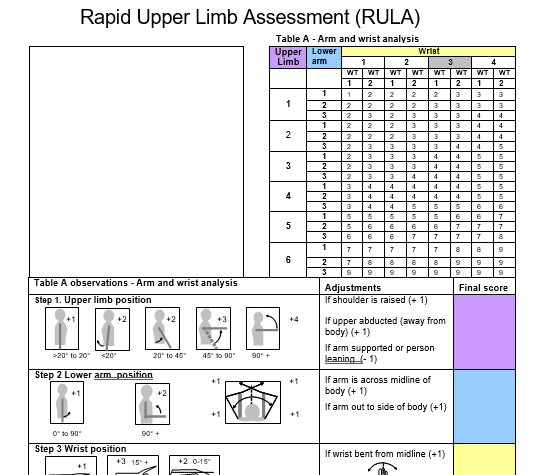Which ergonomic tools work best in today’s workplace?
When it comes to workplace wellbeing, one question comes up time and again: how do we know which ergonomic risks matter most?
Over the years, researchers and practitioners have developed a wide range of assessment tools to help answer that. But with so many options available, which ones really make a difference to employees and employers?
A recent mapping study of the most cited ergonomic tools sheds light on this. The findings show that while technology is starting to play a role, most tools in daily use remain traditional, observational, and highly dependent on the skills of the person applying them.

What are the most widely used ergonomic tools?
Ten tools dominate the field of ergonomic risk assessment.
Among them, the Nordic Questionnaire, RULA (Rapid Upper Limb Assessment), and REBA (Rapid Entire Body Assessment) are the most frequently applied, alongside OWAS, EMG, OCRA, NIOSH, IMU-based sensors, and the Strain Index.
Each of these tools has a particular focus. For example, RULA and REBA target posture and repetitive strain, while NIOSH is used specifically for lifting tasks.
The Nordic Questionnaire, on the other hand, captures workers’ musculoskeletal symptoms over time.

Why is human judgement still so important?
Although digital tools like EMG (which records muscle activity) and IMUs (inertial sensors for tracking motion) can provide highly accurate results, they are often complex, costly, and difficult to use in real-world environments.
This means most workplaces still rely on observation-based methods, which are simpler but heavily dependent on the experience of the assessor.
As a result, assessments can vary between practitioners, making consistency a key challenge.

How is technology changing the picture?
The study highlights that technology adoption in ergonomic assessments is still limited.
While motion sensors, video capture, and even AI-driven posture analysis tools exist, their use has not yet become mainstream.
For businesses, this creates both a risk and an opportunity.
Relying solely on manual observation may overlook key risks, but integrating digital tools could provide a more objective picture of employee wellbeing.
The challenge lies in balancing cost, practicality, and accuracy.

Key takeaways
-
Ten main tools dominate ergonomic assessments, led by NORDIC, RULA, and REBA.
-
Observation remains the most common method, despite advances in technology.
-
Human dependency leads to variation in assessment outcomes.
-
Different tools measure different risks, from posture to load handling.
-
Technology has potential but is still underused in workplaces.

What should you do next?
If you’re responsible for workplace health, start by asking whether your current ergonomic assessments are capturing the right risks. Are you focusing too much on one area, like posture, while missing others, like repetitive strain or lifting?
At Remtek, we specialise in holistic ergonomic assessments that combine tried-and-tested tools with modern approaches.
Contact us today to book an assessment and give your team the benefit of healthier, safer, and more productive work environments.
Email: Enquiries@RemtekWorkplace.com

